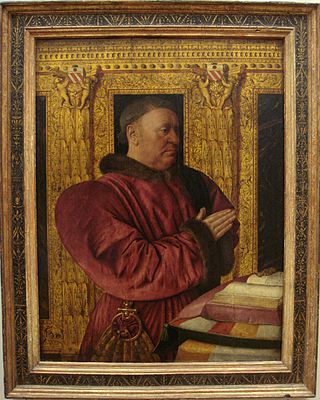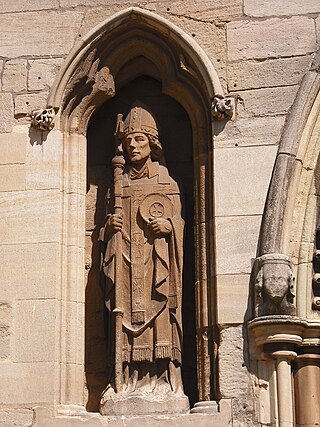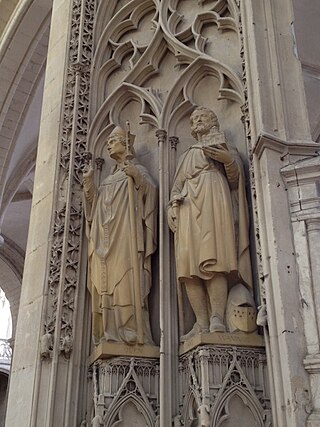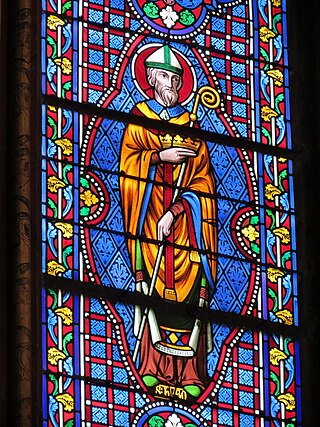
The Chancellor of France, also known as the Grand Chancellor or Lord Chancellor, was the officer of state responsible for the judiciary of the Kingdom of France. The Chancellor was responsible for seeing that royal decrees were enrolled and registered by the sundry parlements, provincial appellate courts. However, since the Chancellor was appointed for life, and might fall from favour, or be too ill to carry out his duties, his duties would occasionally fall to his deputy, the Keeper of the Seals of France.

Adalard of Corbie was the son of Bernard who was the son of Charles Martel and half-brother of Pepin; Charlemagne was his cousin. He is recognised as a saint within the Roman Catholic and Eastern Orthodox Church.

Wulfram of Sens or Wulfram of Fontenelle was the Archbishop of Sens. His life was recorded eleven years after he died by the monk Jonas of Fontenelle. However, there seems to be little consensus about the precise dates of most events whether during his life or post mortem.

Audoin, venerated as Saint Audoin, was a Frankish bishop, courtier, hagiographer and saint. He authored Vita Sancti Eligii which outlines the life and deeds of Eligius, his close friend and companion in the royal court and the Church.

Fontenelle Abbey or the Abbey of St. Wandrille is a Benedictine monastery in the commune of Rives-en-Seine. It was founded in 649 near Caudebec-en-Caux in Seine-Maritime, Normandy, France.

Hugh of Rouen was the son of Duke Drogo of Champagne and his wife Anstrudis. He entered the church and became archbishop of Rouen in 722.

Lydia of Thyatira is a woman mentioned in the New Testament who is regarded as the first documented convert to Christianity in Europe. Several Christian denominations have designated her a saint.
Saint Ansegisus was a monastic reformer of the Franks.

Dom Joseph Pothier, O.S.B. (1835–1923) was a worldwide known French prelate, liturgist and scholar who reconstituted the Gregorian chant.

John the Dwarf, also called John Colobus,John Kolobos or Abba John the Dwarf, was a Coptic Desert Father of the early Christian church.
Eugendus was the fourth abbot of Condat Abbey, at Saint-Claude, Jura.

Leutfridus was a French monk and saint of the eighth century.
Eustace of Luxeuil, also known as Eustasius, was the second abbot of Luxeuil from 611. He succeeded his teacher Columbanus, to whom he had been a favorite disciple and monk. He had been the head of the monastic school.
Sigo was a Burgundian abbot of the sixth century. He is a saint of the Roman Catholic Church, an Orthodox saint and the reputed founder of the Abbey of Saint-Seine and in the Orthodox Church.
Waningus was a Merovingian count and royal official under Clotaire III. He assisted Wandrille in establishing Fontenelle Abbey, and later founded Fécamp Abbey. He is recognized as a Christian saint.
Saint Demetrian is a saint from Cyprus. In the 9th and 10th centuries, he served the Christian Church as a monk and an abbot, and ultimately as the bishop of the ancient city of Khytri. He is venerated for his apparently miraculous rescue of Christian Cypriots who had been enslaved by Saracen invaders.
Saint Lambertus , (625-688), Abbot of Abbey of Fontenelle and Bishop of Lyon (678-688). His feast day is celebrated on 14 April. He was son of Erlebert and so nephew of Robert I, Bishop of Tours. He was born in Quernes where his father was seigneur.
Saint Droctoveus was a Frankish abbot, the first abbot of what became Saint Germain-des-Pres in Paris.

Saint Geremarus was a Frankish monk and abbot. His feast day is 24 September.
Saint Bain, a disciple of Saint Vandrille, was a bishop of Thérouanne in northwest France, and then abbot of the monastery of Saint Wandrille in Normandy. His feast day is 20 June.











